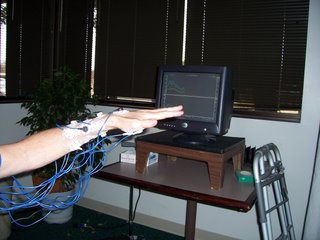E-stim therapy to measure and improve signal to affected hand
At an early phase in my recovery, when I had only barely begun to gain movement with my arm, therapists at the Rehabilitation Institute of Chicago(RIC) introduced a therapy that involved attachment of electrodes to the muscles around my arm and hands to an e-stimulation device that could measure and supplement signal sent from my brain to muscles that moved my hand.
How this works: when you think about moving a muscle, the device detects that Electromyographic (EMG) signal in that muscle. EMG's are electrical activities originating in the brain and transported via nerve cells to the muscles. These signals cause the muscles to contract.Often EMG signals are disturbed after a brain attack leading to paralysis
of muscles. A device can be programmed to provide NeuroMuscular Electrical nerve Stimulation (NMES) by applying an electrical stimulus for muscle rehabilitation. During NMES an electrical impulse is passed from a device to electrodes placed on the skin over a targeted muscle or muscle group. The stimulation causes the muscles to contract. The therapy helps you train the healthy parts of the brain following a stroke to take over the EMG signals that once came from the areas of the brain now affected by stroke. Repetitive use may help achieve voluntary muscle contractions of the paralyzed muscles by causing the brain to assign new brain cells to obtain direct muscle movement, assisted by the device
Why this therapy works: 1.)Visual feedback and positive reinforcement is provided by the device in the form of a real-time graphic display of amount of signal detected (measured in mega volts) and displayed as a X-Y line graph that moves towards the target level represented by horizontal line on graph, so as you increase the intensity of your focus and effort to lift the hand or fingers, the graph provides feedback and positive re-inforcement as the x-y line approaches the target threshold. 2.) bio-feedback and positive re-inforcement is provided by the device in the form of NMES (NeuroMuscular Electrical Stimulation) that causes the target muscles to contract thus completing the motion and providing a sometimes gratifying and exciting sensation of having re-gained voluntary motor control.
NOTE: this therapy alone will not restore function to a hand left paralyzed by stroke but can be enormously helpful if used in conjunction with other therapies that involve strengthening and stretching the muscles in and around the arm and hand andin addition to therapy that establishes a strong foundation in the form of the ability to bear the weight of the body with the affected arm. This mode of therapy is also more appropriate/helpful when only minimal level of signal can be detected. Once a "functional level" of signal can be detected, techniques such as Constraint-Induced Movement Therapy (CIMT), also known as forced use movement therapy might be more effective. One of the newer developments in stroke rehabilitation is called Constraint-Induced Movement Therapy (CIMT), also known as forced use movement therapy. This is an intensive neurorehabilitation therapy that aims to retrain the brain by constraining the unaffected arm and forcing the use of the weakened arm. One of the most exciting aspects of CIMT is that the amount of time since the stroke occurred does not appear to make a difference in the results of the therapy. Participants have regained the use of an affected arm and hand many years after their stroke.
This approach's premise is that the non-use of the weakened side becomes "learned behavior" and the stroke survivor needs constraint induced therapies to re-learn to use and strengthen the weakened side.


